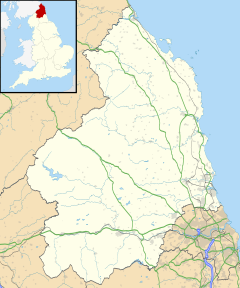world.wikisort.org - United_Kingdom
Holystone is a small village and former civil parish, now in the parish of Harbottle, in Northumberland, England. It lies on the edge of (and just within) the Northumberland National Park on the north bank of the River Coquet. A significant landmark is Holy Well, traditionally the site of early Christian baptisms, and the source of Holystone's water supply.[1] In 1951 the parish had a population of 71.[2]
| Holystone | |
|---|---|
 Holystone | |
 Holystone Location within Northumberland | |
| OS grid reference | NT955025 |
| • London | 275 mi (443 km) SSE |
| Civil parish |
|
| Unitary authority |
|
| Ceremonial county |
|
| Region |
|
| Country | England |
| Sovereign state | United Kingdom |
| Post town | MORPETH |
| Postcode district | NE65 |
| Dialling code | 01669 |
| Police | Northumbria |
| Fire | Northumberland |
| Ambulance | North East |
| UK Parliament |
|
In the early 12th century Holystone became the home of a priory of Augustinian Canonesses. The priory buildings were demolished during the reformation in 1541.[3]
In 1903, Newcastle upon Tyne-based architect Frank West Rich purchased Dues Hill Grange and 3000 acres of land in Holystone, which he subsequently renovated.[4]
Governance
Holystone is in the parliamentary constituency of Berwick-upon-Tweed. On 1 April 1955 the parish was abolished and merged with Harbottle.[5]
References
- "Holystone : The History" Archived 26 July 2014 at the Wayback Machine, Northumberland National Park web site. Retrieved 16 July 2014
- "Population statistics Holystone AP/CP through time". A Vision of Britain through Time. Retrieved 19 January 2022.
- "Holystone Priory, Holystone (Harbottle)", Keys to the Past web site. Retrieved 16 July 2014
- Armstrong, Barrie; Armstrong, Wendy (2013). The Arts and Crafts Movement in the North East of England. A Handbook. Wetherby: Oblong Creative Ltd. p. 235. ISBN 9 780957599215.
- "Relationships and changes Holystone AP/CP through time". A Vision of Britain through Time. Retrieved 19 January 2022.
External links
![]() Media related to Holystone, Northumberland at Wikimedia Commons
Media related to Holystone, Northumberland at Wikimedia Commons
- Details from the National Park's website
- Photographs, concentrating on its Lady's Well
- Illustrated walk through Holystone woods, Northumberland
Другой контент может иметь иную лицензию. Перед использованием материалов сайта WikiSort.org внимательно изучите правила лицензирования конкретных элементов наполнения сайта.
WikiSort.org - проект по пересортировке и дополнению контента Википедии